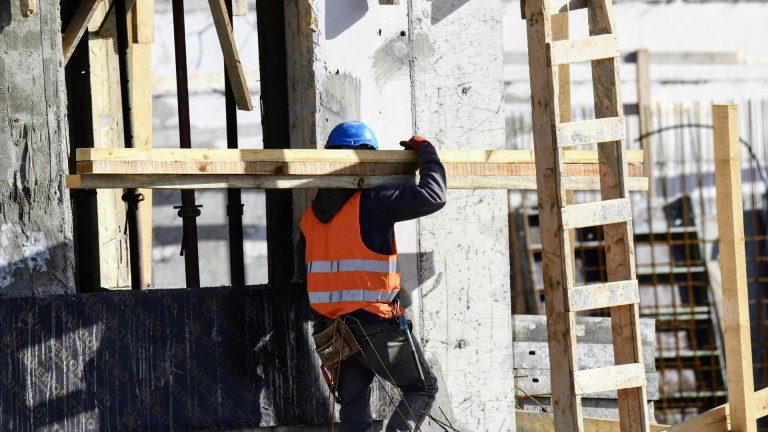‘Both parties are locked into house price growth’
One day in October, Big Issue visited Steele and the team behind Hastings Commons at the Observer Building – a once-derelict newspaper building which is now the centrepiece of a project and a vision to transform the town.
It was still being finished: The floor soon home to flats was still a building site, but on a middle floor open as offices and co-working space there was a buzz of workers tapping away at laptops and making coffees. Heating came from air-source heat pumps, windows were triple glazed, and walls thickly insulated. Here, Steele – whose biography includes squatting in the 90s and an OBE – set out what they’re fighting against.
“We’re so obsessed with the housing ladder. This whole concept of the ladder, that you have to scrabble your way onto it and scrabble your way up it, and that’s the only way to live. I think we have to dump that, we have to try and get away from that idea and get to the idea of decent homes for everybody,” she said. To get the money for Rock House, one of Hastings Commons’ other properties, Steele took out a bigger mortgage on her house, in part to make a point about using “unearned equity”.
“Both parties are locked into house price growth as the only kind of growth that really seems to add anything to the numbers, the economic figures. It’s really scary, and all we can do, I think, is build alternatives,” she said.
The 12 flats in the Observer Building, when they open, will be rented to those coming out of temporary accommodation or at risk of being in temporary accommodation. Rents are kept below market rates, and tenancies are only given to those willing to contribute to the community, and who can demonstrate a local connection. There is no Right to Buy, either – the flats remain in the trust as rentals.
Though they may change lives, 24 properties do not solve a housing crisis. Steele believes Hastings Commons would never own more than 200 homes. But she thinks there may be an answer. Hastings Commons is applying to become a registered provider of social housing, which would allow them to provide social housing in a similar way to a housing association.
Advertising helps fund Big Issue’s mission to end poverty
They have been looking at car parks as a fertile ground for expansion. Flats can be built on top of the existing structure, making use of empty space which is often not considered as a potential site for homes. This could pave the way for hundreds of homes in the town. Beyond Hastings, there are plenty of similar towns across the country with well-loved but run-down assets, Steele said. The idea can spread.
‘There’s nowhere to live. It’s basically a crisis’
It can feel like stumbling into a utopian world inside the Observer Building, all talk of co-creation and doing things differently. But the backdrop is serious.
“It’s quite a divided community, and that’s actually quite a hard thing to work with,” says creative lead Gini Simpson. “There’s nowhere to live. It’s basically a crisis. And in some ways it’s worse than in London, because in London it’s very expensive but there’s lots of different jobs you could get. Whereas down here, there’s not many jobs.”
Getting the community involved, then, is key. This includes a public living room, open to all with no agenda. Anybody over 16 can buy shares in Hastings Commons, and constant feedback is sought on what’s working and what’s not. “This is something that perhaps brings people together, but it’s also a space that reaches out across the community,” says Simpson.
The danger of gentrification is ever-present. Steele, perhaps literally, wrote the book on this. Her PhD, which she completed in 2022, proposed “self-renovating neighbourhoods as an alternative to the false choice of gentrification or decline”. “Any neighbourhood improvement is a potential trigger for gentrification,” Steele told me. “We hold the freehold of the properties. As we add value, we’re not just adding it for someone else.
“You just have to be aware of the issues, but the scale of benefits is much higher than the loss,” she said, adding she saw the only alternative was to do nothing.
Advertising helps fund Big Issue’s mission to end poverty
Funding remains a challenge with the various projects. “It’s really hard, because there’s never quite enough money for any of them,” Steele said. One of Hastings Commons’ major backers is Big Issue Invest, the social investment arm of Big Issue, but money also comes from a patchwork of loans and grants. So far they have spent £7.5m on the Observer Building.
Amid the spreadsheets and the bank balances, there is a constant battle to remain radical, to imagine a different system to the one they work within. There is also a feeling of time running out, a hunger to secure as much land as possible before word gets out and prices shoot out of reach.
“We’re racing the train,” said Steele. “When one day the fast train comes to Hastings like it has to Margate, then the secret will finally be gone.”
Do you have a story to tell or opinions to share about this? Get in touch and tell us more. This Christmas, you can make a lasting change on a vendor’s life. Buy a magazine from your local vendor in the street every week. If you can’t reach them, buy a Vendor Support Kit.









